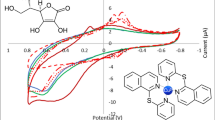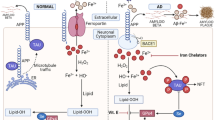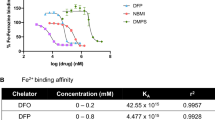Abstract
1. Abundant data suggest that aluminum (Al(III)) exposure may be an environmental risk factor contributing to the development, progression and/or neuropathology of several human neurodegenerative disorders, including Alzheimer's disease (AD).
2. Nuclei appear to be one directed target for Al(III) binding, accumulation, and Al(III)-mediated dysfunction due in part to their high content of polyphosphorylated nucleic acids, nucleotides, and nucleoproteins.
3. The design of chelation therapies dealing with the removal of Al(III) from these genetic compartments therefore represents an attractive strategy to alleviate the development and/or progression of central nervous system dysfunction that may arise from excessive Al(III) exposure.
4. In this study we have investigated the potential application of 10 natural and synthetic Al(III) chelators, including ascorbate (AS), desferrioxamine (DF), and Feralex-G (FG), used either alone or in combination, to remove Al(III) preincubated with intact human brain cell nuclei.
5. Although nuclear bound Al(III) was found to be highly refractory to removal, the combination of AS+FG was found to be particularly effective in removing Al(III) from the nuclear matrix.
6. Our data suggest that chelators carrying cis-hydroxy ketone groups, such as FG, are particularly suited to the removal of Al(III) from complex biological systems.
7. We further suggest a mechanism whereby small chelating molecules may penetrate the nucleus, bind Al(III), diffuse to regions accessible by the larger DF or FG molecules and transfer their Al(III) to DF or FG.
8. The proposed mechanism, called molecular shuttle chelation may provide a useful pharmacotherapy in the potential treatment of Al(III) overload disease.
Similar content being viewed by others
REFERENCES
Allen, D. D., Orvig, C., and Yokel, R. A. (1994). Pharmacokinetics and distribution of tris(maltolato) aluminum (III) into the central nervous system. Neurotoxicology 15:371-378.
Allen, T. D., Cronshaw, J. M., Bagley, S., Kiseleva, E., and Gordberg, M. W. (2000). The nuclear pore complex: Mediator of translocation between nucleus and cytoplasm. J. Cell Sci. 113:1651-1659.
Andrade, J. P., Cadete-Leite, A., Paula-Barbosa, M. M., Volk, B., and Tavares, M. A. (1988). Long-term alcohol consumption reduces the number of neuronal nuclear pores. A morphometric study undertaken in CA3 hippocampal pyramids of rats. Alcohol. Clin. Exp. Res. 12:286-289.
Blanusa, M., Prester, L., Varnai, V. M., Pavlovic, D., Kostial, K., Jones, M. M., and Singh, P. K. (2000). Chelation of aluminium by combining DF and L1 in rats. Toxicology 147:151-156.
Bouras, C., Giannakopoulos, P., Good, P. F., Hsu, A., Hof, P. R., and Perl, D. P. (1987). A laser microscope mass analysis of brain aluminum and iron in dementia pugilistica: Comparison with Alzheimer's disease. Eur. J. Neurol. 38:53-58.
Caravan, P., Rettig, S. J., and Orvig, C. (1997). Effect of pyridyl donors in the chelation of Al(III), gallium(III), and indium(III). Inorg. Chem. 36:1306-1315.
Carpenter, D. O. (2001). Effects of metals on the nervous system of humans and animals. Int. J. Occup. Med. Environ. Health 14:209-218.
Cherny, R. A., Barnham, K. J., Lynch, T., Volitakis, I., Li, Q. X., McLean, C. A., Multhaup, G., Beyreuther, K., Tanzi, R. E., Masters, C. L., and Bush, A. I. (2000). Chelation and intercalation: Complementary properties in a compound for the treatment of Alzheimer's disease. J. Struct. Biol. 130:209-216.
CIBA-GEIGY Limited (1989). Technical Bulletin 992 810.5-957/2, CIBA-GEIGY Limited, Basel, Switzerland.
Crapper, D. R., Quittkat, S., Krishnan, S. S., Dalton, A. J., and de Boni, U. (1980). UItranuclear aluminum content in Alzheimer's disease, dialysis encephalopathy and experimental aluminum encephalopathy. Acta Neuropathol. 50:19-24.
Cuajungco, M. P., Faget, K. Y., Huang, X., Tanzi, R. E., and Bush, A. I. (2000). Metal chelation as a potential therapy for Alzheimer's disease. Ann. N.Y. Acad. Sci. 920:292-304.
Exley, C. A. (1999). A molecular mechanism of aluminium-induced Alzheimer's disease. J. Inorg. Biochem. 76:133-140.
Exley, C., and Korchazhkina, O. (2001). The association of Al and β-amyloid in Alzheimer's disease. In Exley, C. (ed.), Al and Alzheimer's Disease, The Science That Describes the Link, Elsevier, New York, pp. 421-433.
Gelles, J., and Landick, R. (1998). RNA polymerase as a molecular motor. Cell 93:13-16.
Hollosi, M., Shen, Z. M., Perczel, A., and Fasman, G. D. (1994). Stable intrachain and interchain complexes of neurofilament peptides: A putative link between Al3 and Alzheimer disease. Proc. Natl. Acad. Sci. U.S.A. 91:4902-4906.
Joshi, J. G. (1991). Neurochemical hypothesis: participation by Al in producing critical mass of colocalized errors in brain leads to neurological disease. Comp. Biochem. Physiol. 100:103-105.
Kontoghiorghes, G. J. (1995). New concepts of iron and aluminium chelation therapy with oral L1 (deferiprone) and other chelators. Analyst 120:845-851.
Kruck, T. P. A., and Burrow, T. E. (2002). Synthesis of Feralex-G: A novel aluminum/iron chelating compound. J. Inorg. Biochem. 88:19-24.
Kruck, T. P. A., Krishnan, S. S., McLachlan, D. R. C., and Percy, M. E. (2002). Intramuscular injection of desferrioxamine lowers brain Al concentration in patients with Alzheimer's disease. In Khassanova, L., Collery, P. H., Maymard, I., Khassanova, Z., and Etienne, J. C. (eds.), Metal Ions in Biology and Medicine, Vol. 7, John Libbey Eurotext, Paris, pp. 189-192.
Kruck, T. P. A., and McLachlan, D. R. (1989). Aluminum as a pathogenic factor in senile dementia of the Alzheimer type: Ion specific chelation. Prog. Clin. Biol. Res. 317:1155-1167.
Lillie, R. D., Donaldson, P., Jirge, S. K., and Pizzolato, P. (1976). Iron and aluminum lakes of Gallo blue E as nuclear and metachromatic mucin stains. Stain Technol. 51:187-192.
Lovell, M. A., Ehmann, W. D., and Markesbery, W. R. (1993). Laser microprobe analysis of brain aluminum in Alzheimer's disease. Ann. Neurol. 33:36-42.
Lukiw, W. J. (1997). Aluminum in Alzheimer's Disease. In Yasui, M., Strong, M., Ota, K., and Verity, M. A. (eds.), Mineral and Metal Neurotoxicology, CRC Press, Boca Raton, FL, pp. 113-126.
Lukiw, W. J. (2001). Al and gene transcription in the mammalian central nervous system. In Exley, C. (ed.), Al and Alzheimer's Disease, the Science That Describes the Link, Elsevier, New York, pp. 47-68.
Lukiw, W. J., Bergeron, C., Wong, L., Kruck, T. P. A., Krishnan, B., and McLachlan, D. R. C. (1992). Nuclear compartmentalization of aluminum in Alzheimer's disease. Neurobiol. Aging 13:115-121.
Lukiw, W. J., Kruck, T. P. A., and McLachlan, D. R. (1989). Aluminum, intracellular liganding and the nucleus. Lancet 1:781.
Lukiw, W. J., LeBlanc, H. J., Carver, L. A., McLachlan, D. R., and Bazan, N. G. (1998). Run on transcription in human neocortical nuclei-inhibition by nanomolar aluminum and implications for neurodegenerative disease. J. Mol. Neurosci. 11:67-78.
Lukiw, W. J., St. George-Hyslop, P., and McLachlan, D. R. C. (1994). Chromatin structure, nuclear aluminum and gene expression in Alzheimer's disease. In Basic and Clinical Aspects of Neuroscience, Regulation of Gene Expression and Brain Function, Sandoz Publications, Basel, Switzerland, pp. 31-45.
Macdonald, T. L., and Martin, R. B. (1998). Aluminum ion in biological systems. Trends Biochem. Sci. 13:15-19.
Martin, R. B. (1992). Aluminium speciation in biology. Ciba Found. Symp. 169:5-18.
Murayama, H., Shin, R. R., Higuchi, J., Shibuya, S., Muramoto, T., and Kitamoto, T. (1999). Interaction of Al with PHF tau in Alzheimer's disease neurofibrillary degeneration evidenced by desferrioxamine-assisted chelating autoclave method. Am. J. Pathol. 155:877-885.
Pante, N., and Kann, M. (2002). The nuclear pore complex is able to transport macromolecules with diameters of ∼39 nm. Mol. Biol. Cell 13:425-434.
Perl, D. P. (2001). The association of Al and neurofibrillary degeneration in Alzheimer's disease, a personal perspective. In Exley, C. (ed.), Al and Alzheimer's Disease, the Science That Describes the Link, Elsevier, New York, pp. 133-146.
Perl, D. P., Gajdusek, D. C., Garruto, R. M., Yanagihara, R. T., and Gibbs, C. J. (1982). Intraneuronal aluminum accumulation in amyotrophic lateral sclerosis and Parkinsonism-dementia of Guam. Science 217:1053-1055.
Pratico, D., Uryu, K., Sung, S., Tang, S., Trojanowski, J. Q., and Lee, V. M.-Y. (2002). Aluminum modulates brain amyloidosis through oxidative stress in APP transgenic mice. FASEB J. 16:1138-1140.
Rondeau, V., and Commenges, D. (2001). The epidemiology of Al and Alzheimer's disease. In Exley, C. (ed.), Al and Alzheimer's Disease, the Science That Describes the Link, Elsevier, New York, pp. 37-57.
Shin, R.-W. (2001). Al, tau and neurofibrillary degeneration. In Exley, C. (ed.), Al and Alzheimer's Disease, the Science That Describes the Link, Elsevier, New York, pp. 411-420.
Shin, R. W., Kruck, T. P. A., Murayama, H., and Kitamoto, K. (2003). A novel trivalent cation chelator Feralex-G dissociates binding of aluminum and iron associated with hyperphosphorylated tau of Alzheimer's disease. Brain Res. 961:139-46.
Thompson, R. J. (1973). Studies on RNA synthesis in two populations of nuclei from the mammalian cerebral cortex. J. Neurochem. 21:19-40.
Yokel, R. A. (1994). Al chelation: Chemistry, clinical, and experimental studies and the search for alternatives to desferrioxamine. J. Toxicol. Environ. Health 41:131-174.
Yokel, R. A. (2002). Aluminum-chelation principles and recent advances. In Zatta, P. (ed.), Recent Topics in Aluminum Chemistry, Vol. 228: Coordination Chemistry Reviews, Elsevier, New York, pp. 97-113.
Yokel, R. A., Ackrill, P., Burgess, E., Day, J. P., Domingo, J. L., Flaten, T. P., and Savory, J. (1996). Prevention and treatment of Al toxicity including chelation therapy: Status and research needs. J. Toxicol. Environ. Health 48:667-683.
Yokel, R. A., Rhineheimer, S. S., Sharma, P., Elmore, D., and McNamara, P. J. (2001). Entry, half-life, and desferrioxamine-accelerated clearance of brain Al after a single (26)Al exposure. Toxicol. Sci. 64:77-82.
Yoshida, S. (1991). Environmental factors in western Pacific foci of ALS and a possible pathogenetic role of aluminum (Al) in motor neuron degeneration. Rinsho Shinkeigaku 31:1310-1312.
Yoshida, S., Mitani, K., Wakayama, I., Kihira, T., and Yase, Y. (1995). Bunina body formation in amyotrophic lateral sclerosis: A morphometric-statistical and trace element study featuring aluminum. J. Neurol. Sci. 130:88-94.
Author information
Authors and Affiliations
Rights and permissions
About this article
Cite this article
Kruck, T.P., Cui, JG., Percy, M.E. et al. Molecular Shuttle Chelation: The Use of Ascorbate, Desferrioxamine and Feralex-G in Combination to Remove Nuclear Bound Aluminum. Cell Mol Neurobiol 24, 443–459 (2004). https://doi.org/10.1023/B:CEMN.0000022773.70722.b2
Issue Date:
DOI: https://doi.org/10.1023/B:CEMN.0000022773.70722.b2




